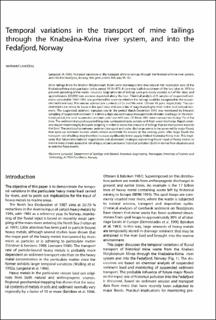| dc.contributor.author | Langedal, Marianne | |
| dc.coverage.spatial | 14123 Fjotland | |
| dc.date.accessioned | 2020-08-26T09:04:38Z | |
| dc.date.available | 2020-08-26T09:04:38Z | |
| dc.date.issued | 1996 | |
| dc.identifier.issn | 0332-5768 | |
| dc.identifier.uri | https://hdl.handle.net/11250/2674135 | |
| dc.description.abstract | Mine tailings from the Knaben Molybdenum Mines were discharged into two lakes in the headwatr area of the Knabeåna-Kvina drainage basin in the period 1918- 1973. A dam was built downstream of the two lakes in 1976 to prevent spreading of the waste. However, large amounts of tailings were previously washed out of the lakes, and approximately 420,000 tons are now deposited along the river. Chemical analysis of 8 samples of suspended sediment, collected in 1993-1994, was performed to examine whether the tailings could be recognised in the sus- pended sediment load. The median acid-soluble content of Cu and Mo were 120 and 44 ppm, repectively. the concentrations are similar to those in the spoil heap and one order of magnitude higher than the local natural sediment. The suspended sediment transport rate in the period March-December 1993 was monitored by frequent sampling of suspended sediment (1-4 times a day) and continuous measurements of water discharge. In the monitored period, the total suspended sediment yield was 600 tons. Of these, 90% were transported during 7% of the time. The sediment transport occurred in pulses corresponding to periods with high water discharge. Rapid variations require monitoring by frequent sampling in order to assess the amounts of tailings that are tran- sported towards the fjord. The relationship between sediment transport and water discharge seems to be governed by major floods that open up sediment sources which remain vulnerable for erosion in the coming years. After large floods the transport rate of tailings may therefore increase significantly in the supply-limited Knabenåna-Kvina river. This implicates that future international negotiations and abatement strategies concerning fluviual input of heavy metals to marine areas should assess the risk of input of particle-bound historical pollution, both in normal flow situations a | |
| dc.language.iso | eng | |
| dc.relation.ispartofseries | NGU Bulletin (430) | |
| dc.rights | Navngivelse 4.0 Internasjonal | |
| dc.rights.uri | http://creativecommons.org/licenses/by/4.0/deed.no | |
| dc.subject | PRØVETAKING | |
| dc.subject | ANALYSE | |
| dc.subject | MILJØGEOLOGI | |
| dc.subject | SEDIMENTTRANSPORT | |
| dc.subject | KILDEOMRÅDE (SEDIMENTOLOGI) | |
| dc.title | Temporal variations in the transport of the mine tailings through the Knabenå-Kvina river system, and into the Fedafjord, Norway | |
| dc.type | Journal article | |
| dc.description.localcode | 44129 | |
| dc.source.pagenumber | 95-101 | |

